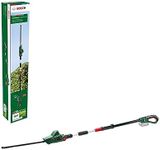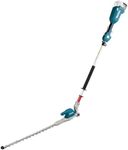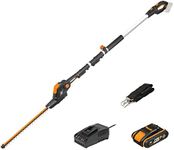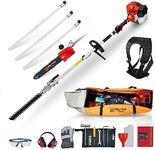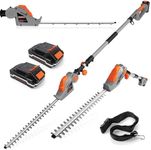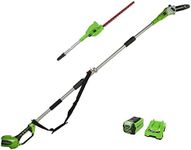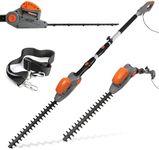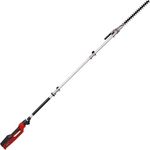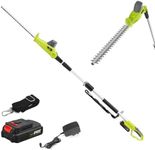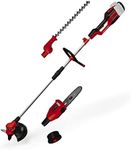Buying Guide for the Best Long Reach Pole Hedge Trimmers
Choosing the right long-reach pole hedge trimmer can make your gardening tasks much easier and more efficient. These tools are designed to help you trim and shape hedges that are tall or hard to reach without the need for a ladder. When selecting a long-reach pole hedge trimmer, it's important to consider several key specifications to ensure you get the best fit for your needs. Here are the main specs to look at and how to navigate them.Blade LengthBlade length determines how much hedge you can cut in one pass. Longer blades (20 inches or more) are great for large hedges and can make the job quicker, but they can be heavier and harder to control. Shorter blades (16-18 inches) are easier to handle and more precise, making them suitable for smaller hedges or detailed work. Choose a blade length based on the size and type of hedges you have.
Pole LengthPole length affects how high you can reach without a ladder. Longer poles (8-10 feet) are ideal for very tall hedges, but they can be more difficult to maneuver. Shorter poles (6-7 feet) are easier to handle and control, making them suitable for medium-height hedges. Consider the height of your hedges and your comfort with handling longer tools when selecting pole length.
WeightThe weight of the trimmer is crucial for ease of use, especially during extended periods of work. Heavier models can be more tiring to use, but they often come with more power and longer blades. Lighter models are easier to handle and reduce fatigue, making them better for smaller jobs or less frequent use. Balance the weight with your physical strength and the duration of your trimming tasks.
Power SourceLong-reach pole hedge trimmers can be powered by electricity (corded), batteries (cordless), or gasoline. Electric models are lighter and quieter but require a power outlet and can be limited by the cord length. Battery-powered models offer more mobility and are quieter, but they need to be recharged and may have limited run time. Gasoline models are the most powerful and offer unlimited mobility, but they are heavier, noisier, and require more maintenance. Choose a power source based on your mobility needs, the size of your garden, and your preference for maintenance.
Cutting CapacityCutting capacity refers to the maximum branch thickness the trimmer can handle. Larger cutting capacities (3/4 inch or more) are suitable for thicker branches and more robust hedges. Smaller capacities (1/2 inch) are adequate for thinner branches and lighter trimming tasks. Assess the thickness of the branches in your hedges to determine the appropriate cutting capacity.
Adjustable HeadAn adjustable head allows you to change the angle of the cutting blade, making it easier to trim the tops and sides of hedges. This feature is particularly useful for shaping and reaching awkward angles. If you have hedges with complex shapes or need to trim at various angles, look for a trimmer with an adjustable head.
ErgonomicsErgonomics refers to how comfortable and easy the trimmer is to use. Features like padded handles, adjustable grips, and balanced weight distribution can make a big difference in reducing strain and fatigue. Consider how comfortable the trimmer feels in your hands and whether it has features that enhance ease of use, especially if you plan to use it for extended periods.
